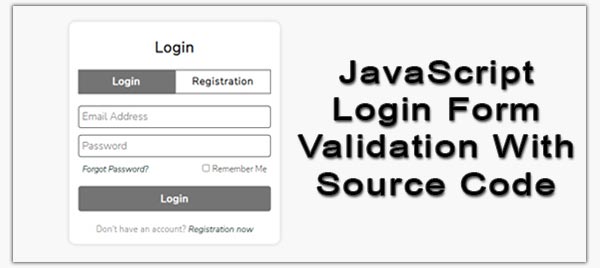Javascript Login Form Validation With Source Code
Last Updated: 2024-02-22 03:35:23
Login form validation is the process of verifying that a user's credentials (email address and password) are correct and matching those stored in a database before allowing the user to log in to a system. This is typically done through the use of a login form, which is a web-based or mobile form that the user fills out with their email address and password.
The purpose of login form validation is to ensure that only authorized users are able to access the system and to prevent unauthorized users from gaining access. It is a critical security measure that helps protect against unauthorized access and data breaches. Download the complete source code of login form validation.
To validate a login form, the system typically checks the following:
- The format of the email address: Is it in the correct format (e.g. name@domain.com)?
- The strength of the password: Does it meet the minimum requirements for length and complexity (e.g. at least 8 characters, with at least one uppercase letter, one lowercase letter, and one number)?
- The presence of empty fields: Are both the email and password fields filled out?
- The accuracy of the email and password: Do they match the email and password stored in the database for the user?
If all of these checks pass, the system allows the user to log in. If any of the checks fail, the system displays an error message and does not allow the user to log in.
👉👉 Five Login Registration Form Example 👈👈
- Login Registration Template With Google And Facebook Buttons
- Login Registration Template With Password Show Hide Feature
- Toggle Login And Registration Form In HTML CSS And JavaScript
- Login Page Template Design With Particle JS Animation
- HTML CSS Login Page Template With Animated Label And Submit Button
Javascript Login Form Validation Steps
Here are the steps involved in performing login form validation using JavaScript:
- Create a login form with input fields for the email address and password.
- Bind the form to a JavaScript function that will handle the validation. This can be done using the onsubmit event attribute of the form element, or by using an event listener to listen for the submit event.
- In the validation function, get the values of the email and password input fields using the getElementById() function.
- Define a regular expression to check the format of the email address, and use the match() function to check if the email address matches the regular expression.
- Check if the password input field is empty.
- Check if the email and password match the email and password stored in the database for the user. This will typically involve sending a request to the server to check the user's credentials.
- If all checks pass, allow the user to log in by submitting the form. If any of the checks fail, display an error message and prevent the form from being submitted.
Javascript Login Form Validation Example
function validateForm() {
// Get the value of the input field with id="email"
var email = document.getElementById("email").value;
// Get the value of the input field with id="password"
var password = document.getElementById("password").value;
// Regular expression to check if the email is in the correct format
var emailRegex = /^[a-zA-Z0-9.!#$%&'*+/=?^_`{|}~-]+@[a-zA-Z0-9-]+(?:\.[a-zA-Z0-9-]+)*$/;
// Check if the email is empty
if (email == "") {
alert("Email field must be filled out");
return false;
}
// Check if the email is in the correct format
if (!email.match(emailRegex)) {
alert("Please enter a valid email address");
return false;
}
// Check if the password is empty
if (password == "") {
alert("Password field must be filled out");
return false;
}
// Send a request to the server to check the user's credentials
// If the credentials are correct, return true to submit the form
// If the credentials are incorrect, display an error message and return false to prevent the form from being submitted
return true;
}Download the complete source code of login form validation.
This function does the following:
- It gets the values of the email and password input fields using the getElementById() function.
- It defines a regular expression to check the format of the email.
- It checks if the email or password input fields are empty.
- It sends a request to the server to check the user's credentials.
- If all checks pass, it returns true to submit the form. If any of the checks fail, it displays an error message and returns false to prevent the form from being submitted.
Check how to design a login registration form using HTML & CSS
Javascript Password Field Validation Steps
- Here are some features that you may want to include in a JavaScript password validation function:
- Minimum length: Requiring the password to be at least a certain length (e.g. 8 characters) helps ensure that the password is strong enough to resist brute force attacks.
- Complexity requirements: Requiring the password to contain a mix of different character types (e.g. uppercase letters, lowercase letters, numbers, and special characters) can make it more difficult for someone to guess the password.
- Password confirmation: Asking the user to enter their password a second time (in a separate field) can help ensure that the user has entered their password correctly.
- Strength meter: A password strength meter is a visual indicator that shows the user how strong their password is based on certain criteria (e.g. length, complexity). This can help the user choose a stronger password.
- Regular expression: A regular expression is a sequence of characters that defines a search pattern. You can use a regular expression to check that the password meets certain criteria (e.g. at least 8 characters long, with at least one uppercase letter, one lowercase letter, and one number).
Here is an example of a password validation function using JavaScript that includes some of these features:
function validatePassword() {
// Get the value of the input field with id="password"
var password = document.getElementById("password").value;
// Get the value of the input field with id="passwordConfirm"
var passwordConfirm = document.getElementById("passwordConfirm").value;
// Regular expression to check if the password is strong enough
var passwordRegex = /^(?=.*[a-z])(?=.*[A-Z])(?=.*\d)[a-zA-Z\d]{8,}$/;
// Check if the password is empty
if (password == "") {
alert("Password field must be filled out");
return false;
}
// Check if the password is strong enough
if (!password.match(passwordRegex)) {
alert("Password must be at least 8 characters long and contain at least one lowercase letter, one uppercase letter, and one number");
return false;
}
// Check if the password confirmation is empty
if (passwordConfirm == "") {
alert("Password confirmation field must be filled out");
return false;
}
// Check if the passwords match
if (password != passwordConfirm) {
alert("Passwords do not match");
return false;
}
// If all checks pass, return true
return true;
}Download the complete source code of login form validation.
This function does the following:
- It gets the values of the password and password confirmation input fields using the getElementById() function.
- It defines a regular expression to check the strength of the password.
- It checks if the password or password confirmation input fields are empty.
- It checks if the passwords match.
- If all checks pass, it returns true. If any of the checks fail, it displays an error message and returns false.
Javascript Email Validation Steps
Here are the steps you can follow to validate an email address in JavaScript:
- Create a regular expression that matches the pattern of a valid email address. This regular expression should check for the following:
- The email address must contain one or more characters before the @ symbol.
- The email address must contain a single @ symbol.
- The email address must contain one or more characters after the @ symbol but before the. symbol.
- The email address must contain a single. symbol, followed by one or more characters.
- Create a function that takes an email address as an argument and uses the regular expression to check if the email address is in the correct format.
- Call the function and pass it to the email address you want to validate.
- If the function returns true, the email address is in the correct format. If it returns false, the email address is not in the correct format.
Here is an example of how you can implement this in JavaScript:
function validateEmail(email) {
var re = /^(([^<>()[\]\\.,;:\s@\"]+(\.[^<>()[\]\\.,;:\s@\"]+)*)|(\".+\"))@((\[[0-9]{1,3}\.[0-9]{1,3}\.[0-9]{1,3}\.[0-9]{1,3}\])|(([a-zA-Z\-0-9]+\.)+[a-zA-Z]{2,}))$/;
return re.test(email);
}
var email = "test@example.com";
if (validateEmail(email)) {
console.log("Valid email address");
} else {
console.log("Invalid email address");
}
Download the complete source code of login form validation.
Note that this regular expression is not a perfect solution and may not catch all invalid email addresses. It is also important to note that validating an email address on the client side using JavaScript does not guarantee that the email address is actually valid. It is always a good idea to validate email addresses on the server side as well.
Still you face problems, feel free to contact with me, I will try my best to help you.

